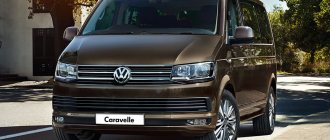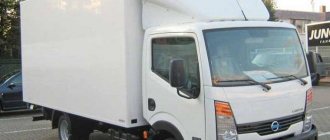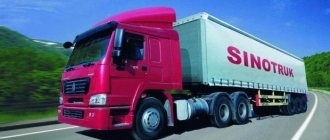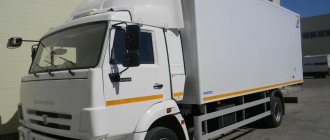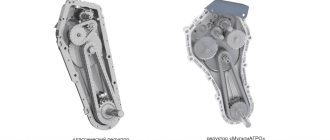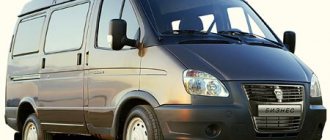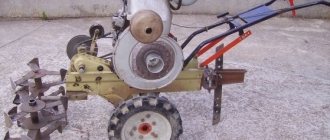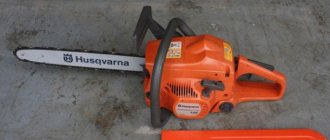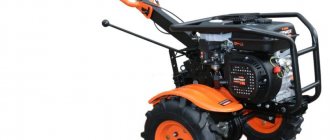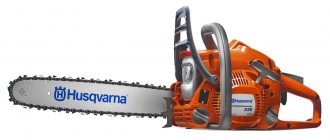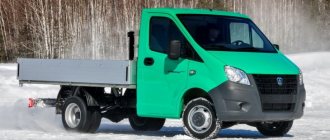Appearance
The car was created as a competitor to the Mercedes Vito and Volkswagen Transporter minivans. And if German minivans seemed like trucks, then the Korean Hyundai is more of a passenger car. There are no strict, angular lines here. All body shapes are smooth and streamlined. At the front there is a neat, slick bumper with round fog lights and oval headlights. There is a cutout in the hood to allow air to flow inside.
What do owners say about the body of the Hyundai H200? As reviews note, the metal on this machine does not rot quickly. Yes, over the years of use some rust appears, but through corrosion is very rare for this car.
Review of Hyundai H200 2.5TD (2000)
When my wife and I still owned a Renault Kangu car, we were very pleased with the ability to carry a lot of cargo (up to 800 kg was loaded) and put in oversized things like a double sofa. In general, I really liked the car, I recommend it to everyone, maybe I’ll write about it later. After 2 years of operation, we naturally wanted more. We started thinking about minivans/minibuses. There was no such thing as a budget. We could only count on the money from the sale of Kanggu + a little. And so these desires hovered sluggishly in the air, until one time, while doing the next maintenance on Renault, I asked my mechanic friends, what would they advise? And they go ahead and say that they just made a small repair on the Hyundai H200, that the owner is selling it and offered to take a look at it.
At first glance I liked the car. Not damaged, not painted, the interior is in good condition, at that time it was 9 years old. And they asked for much less money for it than on the market. I came home and told my wife everything. She caught fire and decided to take it. Very quickly we sold Renault to a friend and bought a 2001 Hyundai H200 for 7,500 bucks, with an average market price of 10-12 thousand.
What did we get?
Long-wheelbase Hyundai H200, with a 2.5TD engine (80 hp), which does not move at all and eats 10 on the highway and 12 in the city, with a super stiff spring suspension in the rear and a stupid torsion bar in the front. The car has an air conditioner, but it immediately broke down (the compressor shaft burst) and we didn’t even try to repair it. The car was imported from Germany with 186 thousand miles. Initially it was a cargo Hyundai H200, then it was converted into a passenger car, and documents were made for a passenger with 8 seats. The previous owners planned to take it fishing and traveling, but things didn’t work out for them, and I quickly understood why. More on this below. When purchased, the car was in excellent condition, nothing needed to be repaired, MOT was done before the sale. We (mainly the wife) started using the car right away. In the first months, we swapped the seats for homemade removable sofas that folded out flat and turned into a full double bed ($380). It was planned to go on holiday in Crimea by car.
We somehow didn’t agree on traveling in this car. The fact is that driving even 100 km in this car is torture. The seats are very uncomfortable, my whole body goes numb on them! The engine, although torquey, is so dull that it is simply impossible to overtake anything on the highway. At a speed of 100 km/h in fifth gear, the engine already develops 3200 rpm! The noise from the engine is deafening, consumption is about 12 liters! Normally you can only drive up to 80 km/h, revs up to 2500. Whoever came up with such a suspension should be hung by the balls in the taiga in winter! Shakes out all the insides even on relatively good roads. This could be understandable if the machine had an increased carrying capacity, but this is not the case! When you try to load 800 kg of building materials into it, the machine simply sits on the bumpers. With such a load, Renault Kangu still drove very cheerfully! The cross-country ability in this car is second to none! “Cow on ice” is the best description! Having driven into the snow, you can safely engage the gear and take your feet off the pedals; the car simply grinds at idle and does not move at all. This is understandable, the ass is completely empty and is not pressed against the road by anything. That's why the car sits in winter.
On top of that, it constantly breaks down. The generator was repaired 4 times! The first time - on January 1 at 23:00 on a mountain road in the cold, all the electrics of the car stupidly turned off, the battery went to zero, the car stalled. The warning light did not light up! Fortunately, there was a good person on the road at such a time, who pulled us to the site, where an hour later they brought us a charged battery, and we were able to get to the city. An autopsy showed that a vacuum pump also sits on the same shaft with the generator, which takes air from the engine crankcase with oil vapors, which over time destroy the seal between the pump and the generator, the oil gets on the brushes and burns. The brushes are not sold separately from the straightener and are integral with it. The item is only original for $80. The second time the contact in the generator was lost, the soldering was unsoldered. Then the tension bolt fell apart and the generator simply fell off. Then the “ears” on which the generator is attached to the block sagged and the generator pulley was no longer coaxial with the pulley of the attached units. This led to the fact that my wife’s belts broke while driving and she had difficulty getting home with a low battery and no brakes. The transmission also broke down. The bushing at the exit from the gearbox broke, causing serious play - an expensive repair that involved removing the gearbox. Then, after a trip with a load of 800 kg, the oil seal in the rear axle squeezed out. At the same time, a broken cardan cross was discovered. Everything was repaired, but the crosspiece turned out to be defective, it was replaced, but again unsuccessfully. Now at a speed of over 80 the car howls, but I don’t have the strength to do it anymore, let it howl.
The engine was also steaming. He's dirty. Changed the pan and lid gasket 3 times, still snotty! The glow plugs were changed 2 times. Then, somewhere during the first year after purchase, the car started getting worse and worse, sometimes it took up to 7 attempts (!) before the engine seized. This went on for 2 years. Then I got tired of carrying my wife’s discharged battery for charging and I took the car to a mechanic. The good craftsmen who did the fuel work on my other car immediately turned me around. The injection pump type is Japanese, electronic, there is no stand for it. They said that they could buy a mechanical fuel injection pump for 500 bucks. They advised me to contact the coolest mechanic in the city. The master turned out to be so pretentious that it was disgusting. I charged 250 bucks just to look, and then depending on the situation. I decided to fix it myself. I thought logically that a diesel engine might not start if there is no compression or fuel. I was confident in the candles. I changed the fuel hoses before and after the filter to transparent ones. And here it is! Air was sucked through the filter, and after stopping the fuel flowed back into the tank. I threw out the original filter and installed a universal one ($7), without pumping and sensors. The car started to start at just a click. Little things were changed along the way; I just remember that basic rubber bands cost several times more than the French ones.
But there must be at least something good in this garbage dump? Why haven't they sold it yet?
There are advantages. We used this machine to do 2 major apartment renovations and build a house. About a dozen apartment moves. A couple of times, ten of us rode nearby in nature. They even took tourists for money. My wife likes to drive it, the car is very maneuverable and easy to control. Excellent visibility, sense of dimensions, excellent rear-view mirrors. Now she stores a stroller and all sorts of things in it under the house that she is too lazy to carry home. This car does better barn work than driving J.
"Hyundai N200": interior
The interior design is typical for those years - the Koreans have already moved away from the usual angular lines. As in appearance, smooth shapes and lines prevail here. The interior is decorated quite simply - a steering wheel without buttons, a dial panel and a modest center console. The seats in the Hyundai H1 H200 are fabric, but very comfortable. The Korean cabin is designed for eight people. If we take into account the “van” version, it can accommodate up to 5.7 cubic meters of cargo.
Among the main advantages of this car, reviews note ergonomics. All controls are in place and intuitive to use. The side mirrors in the car are quite huge. But they are adjusted manually. By the way, for ease of landing, an additional handle is provided in the rack. The driver's seating position itself is quite high. There are no complaints about visibility. Already in the basic configuration, the Hyundai H200 (there is a photo of the car in our article) is equipped with electric windows, one airbag and an air recirculation system. The steering wheel is quite light - there is a hydraulic booster. It is also not uncommon for the Hyundai Starex H200 to come with air conditioning.
Specifications
Different engines were provided for this car, but only two are the most popular in Russia. This is a petrol and diesel unit. Let's start with the first one. This is a naturally aspirated 2.4-liter four-cylinder engine with a 16-valve head. The engine develops power of 110 horsepower. Torque – 181 Nm. A little later this motor was modified. So, with the same volume, it began to develop 135 horsepower, and the torque increased by 10 Nm.
Next on the list is a 2.5-liter turbodiesel unit. Its peculiarity is that it was developed and is highly reliable. Engine power, depending on the degree of boost, ranged from 80 to 170 horsepower. The most powerful engines had a variable geometry turbine and Common Rail direct injection. What do reviews say about diesel engines on the Hyundai H200? Engines are picky about fuel quality. Due to this, problems with starting and failure of glow plugs are possible.
The Hyundai H200 power units have no obvious weaknesses. Moreover, this applies to both gasoline and diesel units. As practice has shown, the service life of these motors can reach 500 thousand kilometers.
HYUNDAI ROBEX 200W-7
home >> equipment catalog >> Road construction equipment >> Excavators >> HYUNDAI ROBEX 200W-7| Engine Cummins B5.9-C (USA) | 166 hp / 1950 rpm |
| Engine capacity | 5880 cm3 |
| Length | 9490 mm |
| Height | 3410 mm |
| Width | 2490 mm |
| Digging depth (max) | 6380 mm |
| Digging force on bucket | 152 kN |
| Digging force at the handle | 101 kN |
| Bucket volume | from 0.51 to 1.34 m3 (0.80 m3 standard) |
| Boom length (mono) | 5650 mm |
| Handle length | 2900 mm |
| Main pump | KAWASAKI, Japan |
| Tandem axial piston pumps with variable displacement | |
| Working pressure | 330kg/cm2 |
| Circuit pressure | 360 kg/cm2 |
| Servo Loop Pressure | 40 kg/cm2 |
| Nominal hydraulic flow | 2x220l/min |
| Rotation speed of slewing motor | 12.5 rpm |
| Movement speed | 8.5/33.0 km/h |
| Fuel consumption - nominal | 136.8 g*l.s/hour at 2100 rpm |
| Battery | 2 x 12v x 100AH |
| Starter | Nippon denso (24V-4.5 kW) |
| Generator | Delco Remy (24V-50AMP) |
| Refill containers: | |
| fuel tank | 310 l |
| oil, engine | 14.2 l |
| cooling system | 35 l |
| g/motors | 5 l |
| hydraulic tank | 180 l |
| hydraulic system | 270 l |
The cabin is made of steel for operation in any weather conditions, and complies with international ISO standards:
- The front and wind windows are made of safety glass and provide excellent all-round visibility;
- Wiper;
- Door with lock;
- Tool box;
- Ashtray.
EQUIPMENT:
- Computer engine power control system 3 operating modes, 2 power modes, 2 user modes
- Automatic speed reset when load decreases
- Automatic engine warm-up mode
- Automatic overheat protection system
- Power boost system (short-term increase in power by 10%)
- self-diagnosis system.
- Central parameter control panel
- Engine temperature indicator
- Oil pressure indicator
- Battery charging indicator
- Engine overheat indicator
- Fluid level indicator
- Hour meter
- Air filter cleaning indicator
- Air conditioning/heater
- Defroster
- Cold start system
- Radio tape recorder
- ZIP-Kit
- Electric pump for fuel injection
- Electrical horn
- Additional hydraulic line for hydraulic attachments.
- Operating temperature range from +50 to -40
- Additional winter heating "Webasto" for starting at low temperatures down to -40
- Fully adjustable driver's seat equipped with seat belts.
- 3 headlights
- Rear blade 610x2490 mm
- Front outriggers
- Tires 10.00-20-14PR
- Consumables for 1 maintenance
- Service tools
- Tachometer
Work zone:
| Name | Handle 2000 mm | Handle 2000 mm | Handle 2400 mm | Handle 2900 mm |
| A | Maximum digging length | 9110 | 9480 | 9900 |
| A' | Maximum digging length at ground level | 8870 | 9260 | 9690 |
| IN | Maximum digging depth | 5480 | 5880 | 6380 |
| IN' | Maximum digging depth at 8 feet | 5240 | 5670 | 6210 |
| WITH | Maximum digging depth when digging a vertical wall | 4970 | 5440 | 5810 |
| D | Maximum digging height | 9500 | 9730 | 9870 |
| E | Maximum soil unloading height | 6670 | 6900 | 7050 |
| F | Minimum platform turning radius | 3700 | 3620 | 3540 |
Buckets:
| Capacity | Width | Weight, kg. | Recommendations, mm | ||||
| 5650 | |||||||
| PSCA, m3 | CECE, m3 | Without side cutter, mm | With side cutter, mm | 2000 | 2400 | 2900 | |
| 0.51 | 0.45 | 700 | 820 | 580 | |||
| 0.80 | 0.70 | 1000 | 1120 | 650 | |||
| 0.87 | 0.75 | 1090 | 1210 | 710 | |||
| 0.92 | 0.80 | 1130 | 1250 | 710 | |||
| 1.20 | 1.00 | 1400 | — | 840 | — | ||
| 1.34 | 1.15 | 1550 | — | 900 | — | ||
| 0.74 | 0.65 | 915 | — | 750 | |||
| 0.90 | 0.80 | 1070 | — | 790 | |||
| 1.05 | 0.92 | 1220 | — | 870 | — | ||
| 0.87 | 0.75 | 1140 | — | 860 | |||
| 0.75 | 0.65 | 1810 | — | 880 | |||
applicable for soil with a density of no more than 2000 kg/m3 or less - applicable for soil with a density of no more than 1600 kg/m3 or less - applicable for soil with a density of no more than 1100 kg/m3 or less -
Transmission
The car is equipped with a five-speed manual transmission or a four-speed automatic. Basically, Hyundai H200 came with a manual transmission. As practice has shown, manual transmission is more durable. But there were some incidents. So, over the years, the speed sensor fails. Another problem with gearboxes on the Hyundai H200 is jolts during a sharp start. Moreover, this happens even on a completely serviceable transmission.
The only criticism is the manual gearbox lever. Due to wear, the gears begin to shift poorly. The clutch resource is quite long - about 150 thousand kilometers. The clutch itself is hydraulically driven. If you change the disc, it should be done together with the bearing. Also, at 200 thousand the clutch cylinder becomes unusable. It starts to flow.
H200
The Hyundai H200 model appeared in 1997. It was developed on the basis of the H1 high-capacity station wagon, a licensed “Japanese” Mitsubishi Space Gear. The “200th” Kommersant was offered in various body options: “combi”, delivery van and chassis with an onboard platform. On the European market, the car found its niche and competed rather with its “brothers” from the East than with famous local manufacturers. The strong point of the H200 is price-quality ratio, the level of which is quite high at Hyundai.
In 2000, the model underwent a minor restyling, and four years later the car was changed more significantly: the design and engines were updated, and safety was improved. In 2007, the second generation of cars debuted under the same H1 index as their passenger cars. The comfort of the H200 is at the proper level. The ergonomics of the driver's seat are quite decent, everything is convenient and understandable. In the passenger version, the cabin can accommodate up to 8 people, and with a van body, the cargo compartment has a usable volume of 4.6 to 5.7 cubic meters. The advantages of the car include a durable body mounted on a ladder-type frame inherited from the Mitsubishi Pajero SUV. Hence, reliable underbody protection and good cross-country ability.
The H200 offered a wide range of engines, but the most common on our market are a 16-valve petrol unit with a displacement of 2.4 liters and a 2.5 liter turbodiesel, manufactured under license from Mitsubishi. The first, depending on the version, developed 110 or 135 hp. (respectively, 181 or 191 Nm at 2500 Nm). Turbodiesel power started at 80 hp. and reached 170 hp. on CRDi engines equipped with a Common Rail system and a variable geometry turbine. By the way, fuel injection pumps of the latest engines suffer from our diesel fuel: there are cases of difficult starts, which are often to blame for the glow plugs.
The car can be accelerated to 160 km/h, although handling at speed is mediocre - the high center of gravity and frame design do their job. The engines have no obvious weak points. With proper care and timely maintenance, both diesel and gasoline units can last up to 500 thousand kilometers. Transmission – 5-speed manual or 4-speed automatic. “Mechanics” has an informative drive, and the unit itself does not cause any complaints, except that sometimes the speed sensor fails. Another feature is jolts in the transmission during a sharp start. This is explained by the total play in the gearbox and the driveshaft crosspieces and is not a defect - you just need to get used to it.
Instances with automatic transmission are very rare among us. Clutch – 1-disc, hydraulically driven. Over time, in addition to the scheduled replacement of the disc and bearing, it may also be necessary to replace the clutch cylinders due to fluid leaks. However, such problems often begin only after 150-200 thousand km. mileage The front suspension of the first generation cars is built according to the classic Asian design - two wishbones and a torsion bar as an elastic element. Since 2007, the car has acquired a McPherson strut, making control easier. At the rear there is a non-split axle, which is suspended on longitudinal springs (unlike the passenger H1, where the rear suspension is semi-independent, on springs).
Most of the problems are related to the springs - the leaves, as well as their bushings, are destroyed. Everything else lasts quite a long time. The steering is rack and pinion type, with hydraulic booster. There are no complaints about its reliability. The system does not lose its tightness even after decent runs, and rack knocking is a fairly rare phenomenon. Front brakes are disc, rear brakes are drum. Second-generation cars also have disc mechanisms at the rear. More recent copies, as well as all cars after 2007, are equipped with ABS and ESP systems - they do not cause trouble for owners.
©. Photos taken from publicly available sources.
- Author: Evgeny Smolnikov
Rate this article:
- 5
- 4
- 3
- 2
- 1
(1 vote, average: 1 out of 5)
Share with your friends!
History of the Mercedes-Benz brand
History of the MAN brand
Chassis
The car has a classic suspension design. At the front there is an independent design with two wishbones. On later versions, a suspension with MacPherson struts appeared. And since this car is rear-wheel drive, a continuous axle is installed at the rear. It is suspended on longitudinal springs. But it is worth noting that such a scheme was only on cargo versions of the Hyundai H200. As for passenger vans, there was a semi-independent suspension with coil springs at the rear. Among the pitfalls regarding the suspension in reviews, drivers note the destruction of leaf springs and bushings.
How does this car drive? The car is moderately rigid and handles like a car. You can easily accelerate to 160 kilometers per hour, but due to the high center of gravity, at speed the car begins to throw from side to side. Therefore, you won’t be able to drive it quickly, unlike the same Vito or Transporter.
Steering, brakes
Steering - rack and pinion with amplifier. This unit is quite reliable, reviews say. The power steering does not leak even after a long period of operation. The rack also does not make knocking noises on our roads.
Now about the brakes. Disc mechanisms are installed at the front, drums at the rear. On later versions, “pancakes” were placed on each axis. The braking system was also equipped with ABS. Sensors do not fail over time. The pads wear out after about 40 thousand kilometers. The owners have no problems with the handbrake on this car.
Trade Group
Technical characteristics: Model name R200W-7 Engine Model Cummins B 5.9-C Type 4-stroke diesel engine with turbocharging Water cooling system Number of cylinders 6 Maximum power 166 hp With. at 2100 min (-1) Rated power 153 hp. With. at 2100 min (-1) Maximum torque 68.4 kgf/m at 1500 min (-1) Piston diameter and stroke 102x120 mm Working volume 5880 l Battery 2x12V 80 A*hour Starter 24V 4.5 kW Generator 24V 50A Hydraulic system Main pump Type two adjustable axial piston pumps with brake valve Maximum oil flow 2x220 l/min Auxiliary pump for the control circuit one gear Hydraulic motors Stroke motors two axial piston pumps with brake valve and parking brake Swing motors axial piston motor with automatic brake Safety valves Operating pressure of working equipment 330 kgf/cm2 The same with a short-term increase in load 360 kgf/cm2 Stroke 360 kgf/cm2 Turning 240 kgf/cm2 Control circuits 40 kgf/cm2 Hydraulic cylinders Boom 2-120x85x1290 mm Handle 1-140x100x1510 mm Bucket 1 -125x85x1055 mm Shovel 2-120x85x226 mm Support 2-130x80x427 mm Movement and brakes Drive 4-wheel hydrostatic Maximum thrust 10800 kg Maximum speed fast/slow 33/8.5 km/h Gradeability 31.5 degrees. Control levers Control levers: two joysticks with one safety level (Left): Turn-Handle, (Right): Boom-Bucket. Steering wheel for maneuvering. Engine throttle control is electric External lighting two headlights are located on the boom, one under the battery compartment, one under the cab Tires/caterpillars tires are double, tubed Size 10.00-20-14PR The turning platform is made of high-strength steel The turning mechanism is an axial piston motor The turning gear is planetary Lubrication system oil bath Hydromechanical disc brake Swing speed 12.5 rpm Control system Type hydraulic cylinders for turning front wheels Maximum turning radius 6690 mm Filling tanks Fuel tank 310 l Coolant 35 l Engine oil 14.2 l Steering motor 5.0 l Front axle 16 l Rear axle 16 l Hydraulic system 270 l Hydraulic tank 180 l Chassis “reinforced D-shaped welded frame protects against deformation” Shovel is a very useful addition for grading and clearing a construction site Outriggers are included for maximum stability when digging and lifting (can be mounted front and rear) Operating Weight Operating weight includes 5650 mm boom, 2900 mm arm, 0.80 m3 bucket, lubricant, coolant, full fuel tank, hydraulic tank and standard equipment Chassis Chassis with rear shovel Chassis with rear legs Chassis with front supports and rear shovel 20500 kg Chassis with front shovel and rear supports 20500 kg Chassis with four supports 20600 kg Standard boom 5650 mm Standard arm 2900 mm Standard bucket 0.80 m3 Geometric digging parameters A Max. digging radius 9100 mm A' Max. digging radius (soil) 8870 mm B Max. digging depth 5480 mm B' Max. digging depth (8′ level) 5240 mm C Max. cutting height when digging 4970 mm D Max. digging height 9500 mm E Max. unloading height 6670 mm F Min. turning radius 3700 mm Additional attachments: hydraulic hammer DELTA F10 Cabin Spacious with ergonomic design, low noise level and excellent visibility. Full view front window, large rear and side windows provide excellent visibility in all directionsLet's sum it up
So, we found out what the Korean Hyundai H200 minivan is. This is a reliable and unpretentious car that will be an excellent assistant for small businesses (if we consider the cargo version), or a good family car for trips to the sea, to the forest, and so on. The machine is quite durable and with proper maintenance will only require replacement of consumables. This is an excellent analogue to expensive German minivans, which have a more complex structure and require maintenance.
